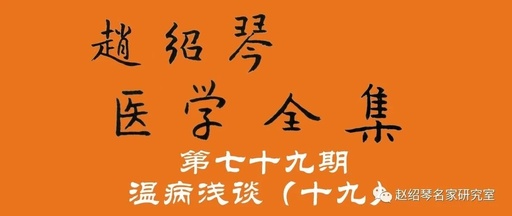Differentiation of Pulse Patterns in Warm Diseases: Deep Pulse and Slow Pulse
Deep Pulse (Chen Mai) is a term referring to the location of the pulse, symbolizing the disease’s entry into the blood level. From the perspective of Wei Qi (Defensive Qi), Ying Qi (Nutritive Qi), and blood, it represents the final stage of warm diseases, which is also a relatively heavy stage. At this time, it is advisable to use Jia Jian Fu Mai Tang (Modified Restore Pulse Decoction) or San Jia Fu Mai Tang (Three-Ingredient Restore Pulse Decoction).
Characteristics: Literature records describe it as being like sand wrapped in cotton, firm inside yet soft outside, akin to a stone thrown into water, which must reach the bottom. The deep pulse is the last stage of pressing down from the floating pulse; it must be pressed firmly to be felt, while light pressure yields no result.
Formation: The formation of a deep pulse is often due to Qi stagnation and blood stasis, poor blood circulation, or the presence of pathogenic factors obstructing the interior, with insufficient righteous Qi, resulting in weak pulsation.
Main Conditions: A deep pulse indicates interior syndromes, such as chronic accumulation, obstruction of Qi mechanisms, retention of water and phlegm, or inability to transform cold fluids. The pulse’s strength indicates whether it is a condition of excess or deficiency. A strong deep pulse indicates interior excess, while a weak deep pulse indicates interior deficiency.
Classification:
Strong and Deep: Indicates excess in the Yangming Fu (Yangming Organ) with internal accumulation, or liver and gallbladder heat obstructing.
Strong and Choppy: Indicates Qi stagnation, liver Qi stagnation with blood deficiency, pain in the flanks, or blood stasis obstructing Qi mechanisms.
Fine and Slippery: A deep pulse indicates interior conditions, fine suggests blood deficiency, while slippery indicates phlegm. This condition is associated with blood deficiency and phlegm stagnation, with disharmony between wood and earth.
Slow and Choppy: Indicates blood deficiency and essence injury, with cold dampness not transforming, and a long-standing condition. Cold dampness and Qi stagnation may require warming and transforming methods to unblock the meridians.
Choppy and Weak: Indicates deficiency of righteous Qi and cold obstruction, with insufficient Qi and blood to push out pathogenic factors, leading to Qi stagnation and cold congealing. Warming and tonifying Qi is necessary, with the use of Gui Zhi (Cinnamon Twig), Fu Zi (Aconite), and Jiang (Ginger) to warm and unblock as a priority, and tonifying the kidneys to warm the Ming Men (Gate of Life) fire as a secondary measure.
Deep pulses are often seen in individuals with middle Qi deficiency, or excessive fat and obesity, or in cases of middle Qi deficiency with water retention, where dampness does not transform, or in cases of extreme anger leading to Qi stagnation. If there is blood stasis or prolonged cold dampness, warming and unblocking should be the primary approach, avoiding excessive heat tonification to prevent unforeseen changes.
Slow Pulse (Huan Mai) refers to a pulse that is slow in rhythm, with a heart rate that is also slow but does not stop.
Characteristics: The normal pulse of a person is slow, soft, harmonious, and has a slippery quality, with a lively rhythm. Pathological slow pulse is characterized by a sense of insufficiency. Although it beats less than four to five beats per breath, the pulsation is weak and the rate is slow, resembling a delayed pulse.
Formation: The formation of a slow pulse is due to Qi obstruction, with poor circulation of Qi and blood. On one hand, it may be due to dampness obstructing Qi mechanisms, such as in slow pulses from damp-heat, and on the other hand, it is often due to deficiency of righteous Qi, with weak spleen and stomach, insufficient energy for the generation of Qi and blood, leading to both Qi and blood deficiency, resulting in weak pulsation.
Main Conditions: Dampness obstructs Qi mechanisms, leading to dampness stagnation, cold dampness obstructing, and insufficient recovery of righteous Qi. Conditions such as damp-heat, cold dampness, water retention, and blood accumulation that does not transform may occur, or in deficient individuals with dampness, or dampness obstructing, with the spleen and stomach unable to transform and transport, leading to chronic cold dampness conditions.
Classification:
Slow and Slippery with Spirit: A normal pulse indicating harmonious Qi and blood, with no injury to the middle Qi, and normal spleen and stomach function.
Slow and Weak: A deep pulse indicates interior conditions, while weakness suggests Qi and blood deficiency. A slow pulse indicates insufficient righteous Qi or dampness obstructing the middle Yang, both indicating deficiency and dampness obstructing, with Qi and blood deficiency requiring warming and nourishing.
Slow, Slippery, and Delayed: This indicates deficiency of righteous Qi, dampness obstructing, insufficient lower source, declining Ming Men fire, and the presence of cold phlegm. Treatment should focus on warming Yang, benefiting fire, and transforming cold phlegm.
Slippery and Slow with Slight Urgency: A slow and slippery pulse indicates dampness obstructing Qi mechanisms, while a deep pulse indicates interior conditions, and slippery resembling urgency suggests internal heat. This is characteristic of damp-heat diseases, with heat lurking internally and dampness obstructing, where the slow pulse indicates Qi affected by dampness. Tongue diagnosis should be referenced to determine the stage of the disease for further treatment.
Weak and Powerless: This indicates middle Qi deficiency and weak energy, with insufficient spleen and stomach function, requiring methods to benefit Qi and tonify the middle.

